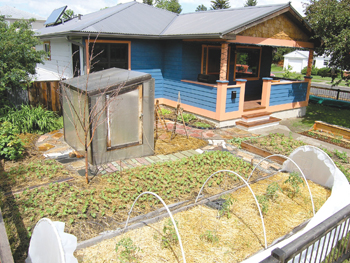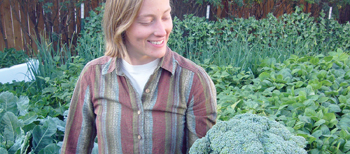To Turf or Not To Turf? That Is The Question
 Ever look out your window, walk down the street, or drive through a neighborhood and find yourself admiring a beautiful lawn? Lush green grass sprawling; an inviting cushion for your feet and body as you nap away a sunny afternoon, or an inviting spot to set-up a spirited game of soccer, croquet, or bocce ball? Whatever feeling these picturesque spots invokes, a beautiful manicured lawn is a fixture in most neighborhoods across America. According to Bozeman based Kate Gardner’s site, OrganicLawnCare101.com, the history of the American lawn is a long and surprisingly intricate one. Originating with England’s wealthy and spinning through the years and influences of turf games, subdivisions, post-war issues, and the invention of the lawnmower, the lawn has become part of the American way of life. As the world has become smaller and the population bigger, concerns have been rising over the value of lawns. What price are Americans truly paying for them?
Ever look out your window, walk down the street, or drive through a neighborhood and find yourself admiring a beautiful lawn? Lush green grass sprawling; an inviting cushion for your feet and body as you nap away a sunny afternoon, or an inviting spot to set-up a spirited game of soccer, croquet, or bocce ball? Whatever feeling these picturesque spots invokes, a beautiful manicured lawn is a fixture in most neighborhoods across America. According to Bozeman based Kate Gardner’s site, OrganicLawnCare101.com, the history of the American lawn is a long and surprisingly intricate one. Originating with England’s wealthy and spinning through the years and influences of turf games, subdivisions, post-war issues, and the invention of the lawnmower, the lawn has become part of the American way of life. As the world has become smaller and the population bigger, concerns have been rising over the value of lawns. What price are Americans truly paying for them?
Energy and waste, resources and space. This concept summarizes the concerns the twenty-first century is facing and the changing mindset of how America plans on managing them. The debate over peak-oil and rising fuel costs has forced Americans to rethink how we do…well just about everything. In addition, the debate over growing climate changes and weather transformations has forced Americans to rethink how we do…well just about everything. Universally people are asking themselves the same basic question, “Where do I waste and do I really need to?” Which brings us back to the stereotypical American lawn. Are the traditional turfs that litter nearly every house, in every city across American space used wisely or are they space wasted unknowingly?
According to the Sustainable Cities Institute (SCI), landscaping constitutes 30% of water consumed daily in the United States. That’s 7,800,000,000 gallons per day! In response to this, and the fact that many grass-based lawns demand heavy water consumption zeroscaping and xeriscaping have emerged. Zeroscaping and zerogardening are landscaping and gardening philosophies that maximize the use of the native plants and succulents to create natural, simple, and elegant environments. Zeroscaping innately requires less water and simultaneously encourages the preservation of native plant species.
Closely related to zeroscaping, xeriscaping and xerogardening focuses more on water conservation, with the ultimate goal being the reduction and even elimination of supplemental water usage. While water conservation is its main goal, xeriscaping also boasts the benefits of reduced utility costs and low maintenance.
Due to increasing drought issues and rising costs of utilities, zeroscaping and xeriscaping have become popular across the country. Some municipalities host annual zeroscaping/xeriscaping contests to encourage communities to take pride in these landscaping methods and reap their rewards. While Bozeman has yet to hold such festivities many locals and local growers are catching on. Senior among these is Westscape, boasting 50+ years of growing experience and specializing in hardy native and adapted Northern Rocky plants. As you drive around the valley, lawn alternative yards are emerging, and where you once found only Kentucky Bluegrass you are now finding Big Sagebrush, Narrow-leaved Yucca, and more native plant species.
Water is not the only waste issue surrounding the traditional lawn. According to the Center for Urban Education about Sustainable Agriculture (CUESA), “shipping foodstuffs long distances for processing and packaging, importing and exporting foods that don’t need to be imported or exported” – are standard practices in the food industry and not only exacerbate a growing fuel issue but they cripple local, domestic businesses. So what does this have to do with our lawns? Urban agriculturalists, to use the term loosely, say it has everything to do with our lawns…that space may be part of the answer. In other words, instead of wasting energy and space on ornamental turfs use it for food production. This approach can not only be aesthetically pleasing, but can also produce quality, local food. CUESA poses an excellent question, bringing to light not only energy and fuel concerns but also economic and food dependency concerns.
Here is an example from CUESA: “On the Hawaiian island of Maui is a sugar processing plant…The sugarcane growing on that acreage is processed in the plant across the street, but only to the ‘raw sugar’ stage. It is then shipped to the C & H Sugar Refinery in Contra Costa County, not far from San Francisco, to be refined…But that’s not the end of its journey: the sugar is then shipped cross-country to New York, where it is packaged into little individual paper packages to be distributed all across the country, including Hawaii. So if you drive a mile away from that sugarcane field and sit in a café, the sugar packets on your table have traveled about 10,000 miles: to California, to New York, and back again to Hawaii, instead of the one mile you have… Nowadays, it is not only tropical foodstuffs that are shipped long distances, but also fruits and vegetables that once grew locally. An apple imported to California from New Zealand is often less expensive than an apple from the historic apple-growing county of Sebastopol, just an hour away from San Francisco. Is it really less expensive in the long run?”
Growing awareness of this problem has prompted people all over the country to begin reconsidering the structure of America’s food industry. Closer to home, Susan Bianchini relocated to the Gallatin Valley in 2004 from three acres of garden paradise in California. In an effort to create a more symbiotic and organic space here, she transformed her front-yard into a garden that “gives back.” Bianchini considers her project on-going, adding plants each year that happen to catch her eye or cross her path. To date you can find anything from rhubarb and broccoli, to asparagus and chives in her garden. Mother of 11 children, Bianchini encourages her children to be an active part of the urban agriculture she has created, maintaining that it provides them with a truly holistic environment.
Alison Sweeney and her husband Andy Knaub moved into their Bozeman home in 2008 and quickly began transforming it. Where once it looked like any other house in America, it swiftly became an urban paradise. Food based gardens replaced lawns, a small beehive emerged to pollinate the gardens, and purposefully chosen flowers became food for their little pollinators. Sweeney, a 6th generation Montanan and avid hunter, hails from a strong sheep ranching and farming background. She explains that it was this upbringing that originally inspired her urban agriculture approach. Values like self-sufficiency, “getting your hands in the dirt,” and quality food paved the way to the oasis Sweeney and her husband now enjoy right at home.
Do these growing concerns and their potential solutions mean an end for the American lawn? The stereotypical one, where expanses of green turf lay unused but readily absorbing a costly resource? Maybe. The traditional lawn, where American families enjoy barbeques, yard games, and sunsets? Absolutely not! It’s all in wisely using your space. As the United States Air Force Sustainable Sites validates, turf space is not necessarily bad, rather it’s the selection of the appropriate plant species, and its size and location that is of importance. For instance, Kentucky Bluegrass can be readily replaced with Buffalo grass (Buchloe dactyloides), which is native to many areas across the United States as well as parts of Mexico. Also, turf does not have to be 100% of your yard. For those of us unwilling to entirely part with our beloved turf, lawn lovers like Kate Gardner offer compelling and valuable tools to more wisely maintain our lawns. Above and beyond these resources are some general rules of thumb:
• Avoid watering during warm hours of the day. Morning and evening watering prevents loss of water to evotranspiration.
• Time and control irrigation to ensure the right plants receive the correct amount of water.
• Use efficient irrigation delivery devices such as drip systems and micro-sprinklers.
• Where sprinkler systems are used, make certain water stays close to the ground to avoid loss to the wind.
• Implement rain cisterns or barrels to collect and reuse rainwater.
• Whenever possible plant native, drought resistant plants and lawns.
So when reflecting on your lawn, whether you live in a home or apartment complex, consider your answer to the big question, “where do I waste, and do I really need to?” Just in these small answers, on neighborhood turfs, America may more readily become equipped to handle the underlying issues: Energy and waste, resources and space…that is the question!
Julie Gandulla is a freelance writer and speaker, as well as a writing and communication consultant. Owner of Zen Shorts In The Rockies, Julie strives to inspire and empower others to communicate effectively with the spoken and written word. www.zenshortsintherockies.com